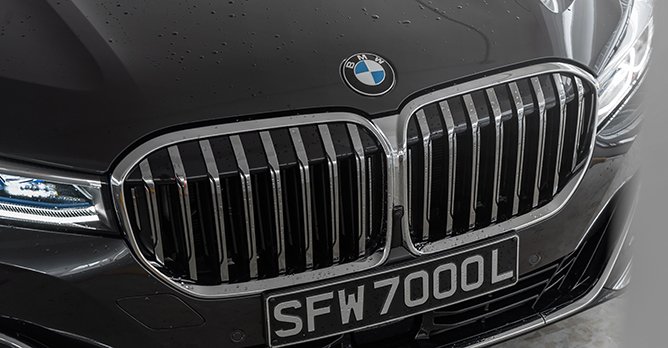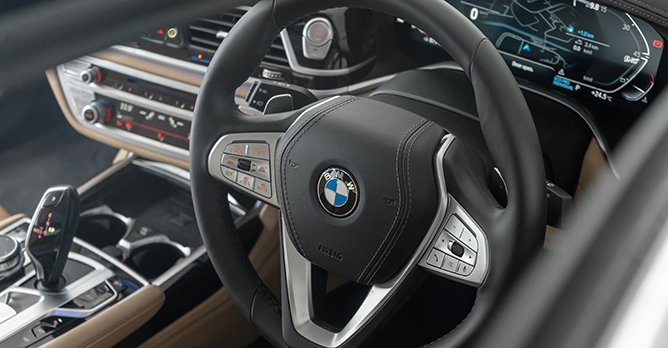BMW 7 Series 740Li Pure Excellence (A) Facelift Review
04 Oct 2019|22,912 views
Facelift (What's New)
Updated exterior with sharper looks, bigger kidney grille
Latest iDrive infotainment system with Digital Cockpit
More power - 3.0-litre turbocharged engine produces 14bhp more, at 340bhp and 450Nm of torque
When it comes to facelifts, we seldom see cars that look vastly different from the ones that came before.
But here, the 7 Series has gotten one, or Life Cycle Impulse as BMW calls it. The visual changes are significant enough that it looks like a whole new model, even if it's still based on the previous 7 Series.
The facelifted BMW 7 Series (left) brings about big visual changes compared to the pre-facelift model (right)
That said, it is a timely update for the 7 Series, because competitors like the Mercedes-Benz S-Class and the Audi A8L have either received facelifts or are completely new models.
Question is: Will the 7 Series be good enough to hold its own against its established and newer competitors?
Big changes outside
The most visible differences are on the 7er's sheet metal. Let's start off with the grille. It is big - up to 40% larger and 50mm taller than the previous model.
Surprisingly, despite the size of the grille, the 7 Series as a whole looks much slimmer and athletic compared to before. Further accentuating this characteristic are the slimmer head and taillights, the latter being 35mm slimmer.
Small changes inside
Inside, those familiar with the 7 Series might find it looking pretty similar. It doesn't sport the new gear selectors we've seen in the X7, or the neater centre console buttons, for example.
Still, it is only till you meddle around a little more that you'll notice the subtle changes.
The iDrive infotainment system is now running BMW's latest Operating System 7.0, and it also sports a crisp 10.25-inch Live Cockpit digital display, instead of the semi-digital dials of before. Calling out "Hey BMW" will also bring out the car's Personal Assistant, a feature that's also found in the 3 Series.
Despite minimal changes, the 7 Series still offers a well-appointed interior befitting of its flagship sedan status. But you can't help to feel that it does come across as a little dated when compared to the brand's other flagship offerings like the X7 and the 8 Series Coupe.
More power is better
The next improvement happens under the hood. The 740Li gets a 3.0-litre turbocharged straight-six that now pushes out about 14 more horses, totalling the power output to 355bhp and 450Nm of torque.
But here, the 7 Series has gotten one, or Life Cycle Impulse as BMW calls it. The visual changes are significant enough that it looks like a whole new model, even if it's still based on the previous 7 Series.
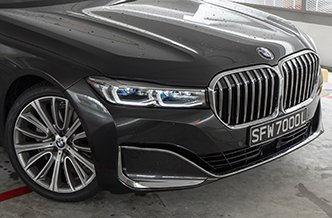 | 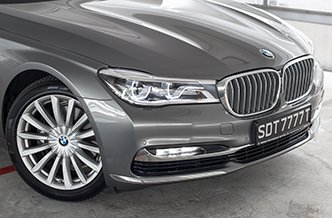 |
That said, it is a timely update for the 7 Series, because competitors like the Mercedes-Benz S-Class and the Audi A8L have either received facelifts or are completely new models.
Question is: Will the 7 Series be good enough to hold its own against its established and newer competitors?
Big changes outside
The most visible differences are on the 7er's sheet metal. Let's start off with the grille. It is big - up to 40% larger and 50mm taller than the previous model.
Surprisingly, despite the size of the grille, the 7 Series as a whole looks much slimmer and athletic compared to before. Further accentuating this characteristic are the slimmer head and taillights, the latter being 35mm slimmer.
Small changes inside
Inside, those familiar with the 7 Series might find it looking pretty similar. It doesn't sport the new gear selectors we've seen in the X7, or the neater centre console buttons, for example.
Still, it is only till you meddle around a little more that you'll notice the subtle changes.
The iDrive infotainment system is now running BMW's latest Operating System 7.0, and it also sports a crisp 10.25-inch Live Cockpit digital display, instead of the semi-digital dials of before. Calling out "Hey BMW" will also bring out the car's Personal Assistant, a feature that's also found in the 3 Series.
Despite minimal changes, the 7 Series still offers a well-appointed interior befitting of its flagship sedan status. But you can't help to feel that it does come across as a little dated when compared to the brand's other flagship offerings like the X7 and the 8 Series Coupe.
More power is better
The next improvement happens under the hood. The 740Li gets a 3.0-litre turbocharged straight-six that now pushes out about 14 more horses, totalling the power output to 355bhp and 450Nm of torque.
Yes, the 7 Series is reasonably brisk, and getting up to speed is effortless. It rides impressively well, too, without being floaty and devoid of any feel. More importantly, it is how easy it is to put this big luxury sedan on the road.
In fact, its not harder to drive than, say, a 5 Series, thanks to the clear and wide view that the 7 Series offers the driver.
Plus, it has a full suite of safety assistance features like Lane Keep Assist and Blind Spot Monitoring, plus a 360-degree camera for driving through tight areas. Thus, there's no reason to be overwhelmed driving a big car like the 7 Series.
You only notice the sizeable footprint when you've parked the car. The nose of car tends to stick out of standard size parking lots, with the big kidney grille taking precedence.
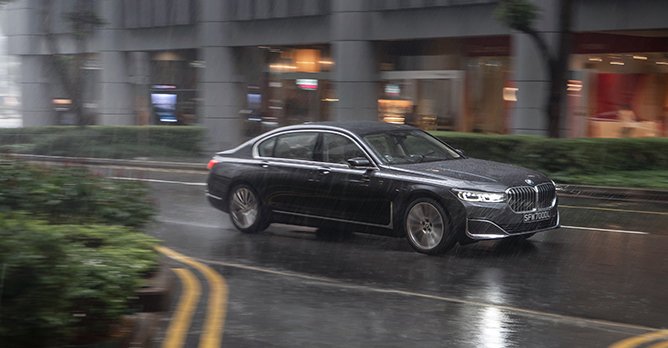
 The 7 Series isn't a hard car to pilot despite its size, and feels nimble and easy to place even in tight spaces
The 7 Series isn't a hard car to pilot despite its size, and feels nimble and easy to place even in tight spaces
Still top-of-the-line
Changes however big or small, we can agree that the 7 Series is now fresher than before. It still offers the same luxurious experience for those who can afford its $469,888 (as of 3 October 2019) asking price as it did before, too.
You could compare this to the facelifted S-Class. The Merc sported updates that mainly related to driver assist systems and infotainment. It is glitzy and glamorous on the inside, but it effectively looks the same as it did back in 2014.
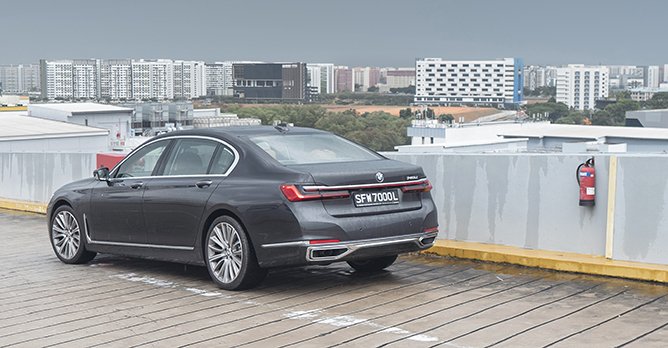
 If you're looking for a large luxury sedan that is both comfortable and nice to drive, the 7 Series is it
If you're looking for a large luxury sedan that is both comfortable and nice to drive, the 7 Series is it
The Audi A8L, on the other hand, may be new, but it doesn't have the same visual presence like the 7 Series.
And that is why we reckon the BMW trumps its competitors in a segment where first impression counts the most.
In short, if you want a large luxury sedan with a big impact, the 7 Series could well be it. It has the looks and the luxury that will punch its way through the competition.
In fact, its not harder to drive than, say, a 5 Series, thanks to the clear and wide view that the 7 Series offers the driver.
Plus, it has a full suite of safety assistance features like Lane Keep Assist and Blind Spot Monitoring, plus a 360-degree camera for driving through tight areas. Thus, there's no reason to be overwhelmed driving a big car like the 7 Series.
You only notice the sizeable footprint when you've parked the car. The nose of car tends to stick out of standard size parking lots, with the big kidney grille taking precedence.

Still top-of-the-line
Changes however big or small, we can agree that the 7 Series is now fresher than before. It still offers the same luxurious experience for those who can afford its $469,888 (as of 3 October 2019) asking price as it did before, too.
You could compare this to the facelifted S-Class. The Merc sported updates that mainly related to driver assist systems and infotainment. It is glitzy and glamorous on the inside, but it effectively looks the same as it did back in 2014.

The Audi A8L, on the other hand, may be new, but it doesn't have the same visual presence like the 7 Series.
And that is why we reckon the BMW trumps its competitors in a segment where first impression counts the most.
In short, if you want a large luxury sedan with a big impact, the 7 Series could well be it. It has the looks and the luxury that will punch its way through the competition.
Facelift (What's New)
Updated exterior with sharper looks, bigger kidney grille
Latest iDrive infotainment system with Digital Cockpit
More power - 3.0-litre turbocharged engine produces 14bhp more, at 340bhp and 450Nm of torque
When it comes to facelifts, we seldom see cars that look vastly different from the ones that came before.
But here, the 7 Series has gotten one, or Life Cycle Impulse as BMW calls it. The visual changes are significant enough that it looks like a whole new model, even if it's still based on the previous 7 Series.
Question is: Will the 7 Series be good enough to hold its own against its established and newer competitors?
Big changes outside
The most visible differences are on the 7er's sheet metal. Let's start off with the grille. It is big - up to 40% larger and 50mm taller than the previous model.
Surprisingly, despite the size of the grille, the 7 Series as a whole looks much slimmer and athletic compared to before. Further accentuating this characteristic are the slimmer head and taillights, the latter being 35mm slimmer.
Small changes inside
Inside, those familiar with the 7 Series might find it looking pretty similar. It doesn't sport the new gear selectors we've seen in the X7, or the neater centre console buttons, for example.
Still, it is only till you meddle around a little more that you'll notice the subtle changes.
The iDrive infotainment system is now running BMW's latest Operating System 7.0, and it also sports a crisp 10.25-inch Live Cockpit digital display, instead of the semi-digital dials of before. Calling out "Hey BMW" will also bring out the car's Personal Assistant, a feature that's also found in the 3 Series.
Despite minimal changes, the 7 Series still offers a well-appointed interior befitting of its flagship sedan status. But you can't help to feel that it does come across as a little dated when compared to the brand's other flagship offerings like the X7 and the 8 Series Coupe.
More power is better
The next improvement happens under the hood. The 740Li gets a 3.0-litre turbocharged straight-six that now pushes out about 14 more horses, totalling the power output to 355bhp and 450Nm of torque.
But here, the 7 Series has gotten one, or Life Cycle Impulse as BMW calls it. The visual changes are significant enough that it looks like a whole new model, even if it's still based on the previous 7 Series.
The facelifted BMW 7 Series (left) brings about big visual changes compared to the pre-facelift model (right)
That said, it is a timely update for the 7 Series, because competitors like the Mercedes-Benz S-Class and the Audi A8L have either received facelifts or are completely new models. Question is: Will the 7 Series be good enough to hold its own against its established and newer competitors?
Big changes outside
The most visible differences are on the 7er's sheet metal. Let's start off with the grille. It is big - up to 40% larger and 50mm taller than the previous model.
Surprisingly, despite the size of the grille, the 7 Series as a whole looks much slimmer and athletic compared to before. Further accentuating this characteristic are the slimmer head and taillights, the latter being 35mm slimmer.
Small changes inside
Inside, those familiar with the 7 Series might find it looking pretty similar. It doesn't sport the new gear selectors we've seen in the X7, or the neater centre console buttons, for example.
Still, it is only till you meddle around a little more that you'll notice the subtle changes.
The iDrive infotainment system is now running BMW's latest Operating System 7.0, and it also sports a crisp 10.25-inch Live Cockpit digital display, instead of the semi-digital dials of before. Calling out "Hey BMW" will also bring out the car's Personal Assistant, a feature that's also found in the 3 Series.
Despite minimal changes, the 7 Series still offers a well-appointed interior befitting of its flagship sedan status. But you can't help to feel that it does come across as a little dated when compared to the brand's other flagship offerings like the X7 and the 8 Series Coupe.
More power is better
The next improvement happens under the hood. The 740Li gets a 3.0-litre turbocharged straight-six that now pushes out about 14 more horses, totalling the power output to 355bhp and 450Nm of torque.
Yes, the 7 Series is reasonably brisk, and getting up to speed is effortless. It rides impressively well, too, without being floaty and devoid of any feel. More importantly, it is how easy it is to put this big luxury sedan on the road.
In fact, its not harder to drive than, say, a 5 Series, thanks to the clear and wide view that the 7 Series offers the driver.
Plus, it has a full suite of safety assistance features like Lane Keep Assist and Blind Spot Monitoring, plus a 360-degree camera for driving through tight areas. Thus, there's no reason to be overwhelmed driving a big car like the 7 Series.
You only notice the sizeable footprint when you've parked the car. The nose of car tends to stick out of standard size parking lots, with the big kidney grille taking precedence.

 The 7 Series isn't a hard car to pilot despite its size, and feels nimble and easy to place even in tight spaces
The 7 Series isn't a hard car to pilot despite its size, and feels nimble and easy to place even in tight spaces
Still top-of-the-line
Changes however big or small, we can agree that the 7 Series is now fresher than before. It still offers the same luxurious experience for those who can afford its $469,888 (as of 3 October 2019) asking price as it did before, too.
You could compare this to the facelifted S-Class. The Merc sported updates that mainly related to driver assist systems and infotainment. It is glitzy and glamorous on the inside, but it effectively looks the same as it did back in 2014.

 If you're looking for a large luxury sedan that is both comfortable and nice to drive, the 7 Series is itThe Audi A8L, on the other hand, may be new, but it doesn't have the same visual presence like the 7 Series.
If you're looking for a large luxury sedan that is both comfortable and nice to drive, the 7 Series is itThe Audi A8L, on the other hand, may be new, but it doesn't have the same visual presence like the 7 Series.
And that is why we reckon the BMW trumps its competitors in a segment where first impression counts the most.
In short, if you want a large luxury sedan with a big impact, the 7 Series could well be it. It has the looks and the luxury that will punch its way through the competition.
In fact, its not harder to drive than, say, a 5 Series, thanks to the clear and wide view that the 7 Series offers the driver.
Plus, it has a full suite of safety assistance features like Lane Keep Assist and Blind Spot Monitoring, plus a 360-degree camera for driving through tight areas. Thus, there's no reason to be overwhelmed driving a big car like the 7 Series.
You only notice the sizeable footprint when you've parked the car. The nose of car tends to stick out of standard size parking lots, with the big kidney grille taking precedence.

Still top-of-the-line
Changes however big or small, we can agree that the 7 Series is now fresher than before. It still offers the same luxurious experience for those who can afford its $469,888 (as of 3 October 2019) asking price as it did before, too.
You could compare this to the facelifted S-Class. The Merc sported updates that mainly related to driver assist systems and infotainment. It is glitzy and glamorous on the inside, but it effectively looks the same as it did back in 2014.

And that is why we reckon the BMW trumps its competitors in a segment where first impression counts the most.
In short, if you want a large luxury sedan with a big impact, the 7 Series could well be it. It has the looks and the luxury that will punch its way through the competition.
Car Information
BMW 7 Series 740Li Pure Excellence (A)
CAT B|Petrol|12.7km/L
Horsepower
250kW (335 bhp)
Torque
450 Nm
Acceleration
5.6sec (0-100km /hr)
This model is no longer being sold by local distributor
All Used BMW 7 SeriesThank You For Your Subscription.




































